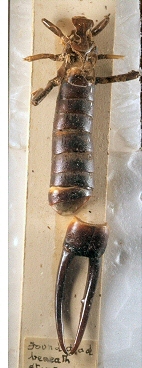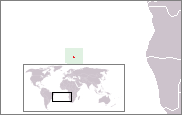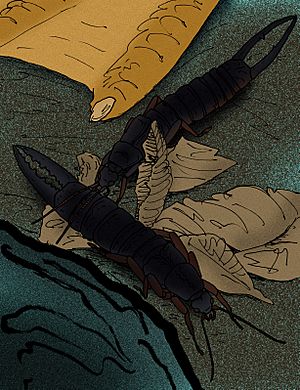Saint Helena earwig facts for kids
Quick facts for kids Saint Helena earwig |
|
|---|---|
 |
|
| Preserved specimen with dislocated posterior | |
| Conservation status | |
| Scientific classification | |
| Genus: |
Labidura
|
| Species: |
herculeana
|
 |
|
| Location of Saint Helena | |
| Synonyms | |
|
Labidura loveridgei Zeuner, 1962 |
|
The Saint Helena earwig (Labidura herculeana) was a truly giant earwig. It lived only on the remote island of Saint Helena in the south Atlantic Ocean. Sadly, this amazing insect is now extinct, meaning it no longer exists anywhere in the world.
Contents
What Did the Saint Helena Earwig Look Like?
This earwig was the biggest earwig ever known! It could grow up to 84 millimeters (about 3.3 inches) long, including its tail pincers. Imagine an earwig almost as long as your palm!
It had a shiny black body and reddish legs. It also had short wing covers, called elytra, but it didn't have any back wings, so it couldn't fly.
Where Did the Saint Helena Earwig Live?
This special earwig was found only on Saint Helena Island. It lived in flat, open areas and in forests with gumwood trees. It was also found near seabird colonies in rocky places.
The earwigs lived in deep burrows underground. They usually came out only at night, especially after it rained. Female earwigs were known to be very good mothers, caring for their young.
How Was the Saint Helena Earwig Discovered?
The Saint Helena earwig was first found by a Danish scientist named Johan Christian Fabricius in 1798. He gave it the scientific name Labidura herculeana. For a long time, people thought it was just a bigger version of a common shore earwig.
Then, in 1962, two bird scientists, Douglas Dorward and Philip Ashmole, found some huge tail pincers. They were looking for bird bones on the island. These pincers were so big that they knew they belonged to a giant earwig!
A zoologist named Arthur Loveridge confirmed they were from a very large earwig. Another scientist, F. E. Zeuner, thought it was a new species and named it Labidura loveridgei.
Finding Live Earwigs
In 1965, scientists finally found live Saint Helena earwigs! They were living in burrows under rocks. After studying them, they realized these were the same giant earwigs that Fabricius had named Labidura herculeana back in 1798. So, the name Labidura herculeana became its official scientific name again.
The last time anyone reported seeing a live Saint Helena earwig was in 1967. Since then, many searches have been done, but no more live earwigs have been found.
Efforts to Find the Earwig Again
People tried hard to find the earwig.
- In 1982, Saint Helena issued a special stamp with the earwig on it. This helped bring attention to its possible disappearance.
- In 1988, the London Zoo started "Project Hercules" to search for it, but they didn't find any.
- In 1995, more earwig remains were found. This showed that the earwigs also lived in seabird colonies, not just gumwood forests.
- In 2005, Howard Mendel from the Natural History Museum also searched, but without success.
Why Did the Saint Helena Earwig Disappear?
The Saint Helena earwig has not been seen alive since 1967. Scientists believe it became extinct for a few main reasons:
- Habitat Loss: Many of the surface stones where the earwigs lived were removed for building. This destroyed their homes.
- New Predators: Animals brought to the island by humans, like rodents, mantids, and centipedes (especially Scolopendra morsitans), hunted and ate the earwigs.
In 2014, the IUCN Red List officially changed the status of the Saint Helena earwig from "Critically Endangered" to "Extinct." This means scientists believe it is gone forever.
Images for kids
-
Location of Saint Helena
See also
 In Spanish: Tijereta gigante para niños
In Spanish: Tijereta gigante para niños




